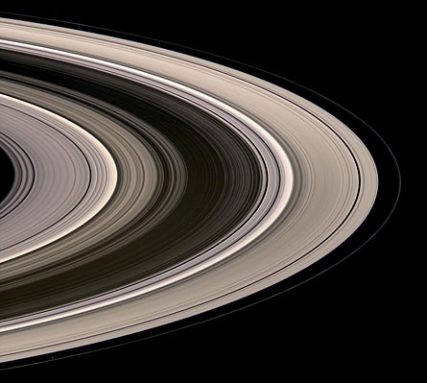A new look at Saturn’s rings
New information from space missions suggests Saturn's rings may be older and have more mass than scientists thought
 |
|
This portrait of Saturn’s rings looks toward the northern side, which is not lit by the sun. Sunlight lights up the rings from below, though, and light not reflected scatters through the rings’ particles, making them glow.
|
| JPL/NASA, Space Science Institute |
Many students know that to figure out the age of a tree, you count the number of rings that make up its trunk. The tree adds another ring each year. But what if you wanted to know the age of the rings that surround the planet Saturn?
It’s a tricky question that scientists have tried to answer for decades. In the late 1970s, the National Aeronautics and Space Administration, or NASA, sent a pair of spacecraft called Voyager 1 and Voyager 2 into outer space. Part of their mission was to fly past Saturn. They would take pictures and collect data about the planet, then send all these data back to Earth.
From those data, scientists first estimated that the rings surrounding Saturn were a mere 100 million years old. Even though that sounds very old, 100 million years is actually quite young when compared with the solar system. It’s a whopping 4.6 billion years old.
Looking at the physical characteristics of the particles that make up the rings is partly what helped astronomers determine their age. They reasoned that because the rings appear shiny and reflective, the particles in them, and the rings themselves, were fairly young. The scientists thought that the particles were young because they had not been around long enough for their surfaces to become darkened and less reflective. Things like dust and craters left from collisions with small meteorites can get particles dirty.
But a team of researchers in Colorado now thinks Saturn’s rings might be much closer to the age of the solar system itself. These researchers used a combination of computer analyses, which mimic events, and data from the Cassini spacecraft, a satellite now orbiting Saturn and collecting data.
In the computer simulation, the team estimated the gravitational pull, a force that pulls objects together, between each of the particles making up the rings. Big particles in the rings may pull smaller particles to themselves, where they stick and make one larger particle. In their simulations, the researchers found that the particles making up Saturn’s rings stick together in clumps and are not uniformly distributed, as previously thought.
The formation of new, larger ring particles from older, smaller ones could erase any surface darkening from previous collisions with meteorites, the researchers reasoned. They suggest the particles may look younger than they really are because they constantly clump together, possibly burying the cratered, dusty surface of the older particles beneath the surface of the new clumped particles.
Because of these clumped particles, scientists may have also underestimated the mass of the rings. Previously, astronomers calculated the mass of the rings by measuring how much starlight their particles blocked. The thinking was that the amount of blocked starlight could tell the amount of material in the rings. The more starlight was blocked, the more mass was present in the rings, the scientists reasoned.
But the older calculation assumed the particles were fairly evenly spread out in the rings. These newer data suggest the particles in the rings are clumped together with large empty spaces between them. In that arrangement, more light passes through than if the same mass of particles was spread evenly, as previously thought. This new understanding suggests Saturn’s rings contain much more mass than scientists first estimated.
Taken together, the findings raise new questions about the estimated age of Saturn’s rings, says Mark Lewis. He’s a computer scientist at Trinity University in San Antonio, Texas. But until astronomers know more about what material the ring particles are made of, and details about how they clump together, the age of Saturn’s rings will remain an astronomical puzzle.







